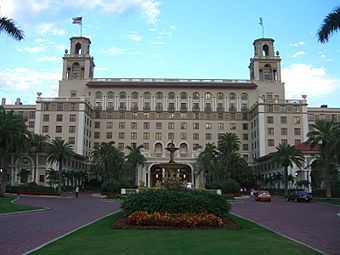The Breakers (hotel) facts for kids
Quick facts for kids |
|
|
Breakers Hotel Complex
|
|
 |
|
| Location | 1 South County Road Palm Beach, Florida |
|---|---|
| Area | 105 acres (42 ha) |
| Built | 1925 |
| Architect | Schultze & Weaver |
| Architectural style | Renaissance Revival, Late Nineteenth and Twentieth Century Revivals, Shingle Style |
| NRHP reference No. | 73000598 |
| Added to NRHP | August 14, 1973 |
The Breakers Palm Beach is a famous luxury hotel. It is located in Palm Beach, Florida, United States. This hotel has 538 rooms. It is known for its beautiful Renaissance Revival style.
Contents
The Breakers Hotel: Early Days
The hotel first opened on January 16, 1896. It was called The Palm Beach Inn back then. A rich businessman named Henry Flagler built it. He wanted a place for travelers on his Florida East Coast Railway. The hotel was right on the beach. Guests started asking for rooms "over by the breakers" (the ocean waves). So, in 1901, Flagler changed its name to The Breakers Hotel.
Fires and Rebuilding the Breakers
The first wooden hotel burned down on June 9, 1903. But it was quickly rebuilt! The new hotel opened on February 1, 1904. Rooms cost $4 a night, which included three meals. That was a lot of money back then! Flagler did not allow cars on the property. So, guests rode between hotels in special wheeled chairs. Employees pushed these chairs. The hotel also had a nine-hole golf course.
The Breakers Hotel burned down again on March 18, 1925. This time, an electric curling iron was left on. Flagler's family hired a company called Schultze and Weaver. They designed a new building with 550 rooms. It looked like the Villa Medici in Rome, Italy.
Building a Fireproof Hotel
The builders decided to use concrete this time. Concrete is much safer from fires than wood. About 1,200 workers built the new hotel. It opened on December 29, 1926. Everyone loved it! An artist named Alexander Bonanno painted the lobby ceiling. This hotel even inspired the design of the Hotel Nacional de Cuba in Havana, Cuba.
Recognizing The Breakers' History
The Breakers Hotel was added to the National Register of Historic Places in 1973. This means it is a very important historical place. The area listed was about 105 acres. It included 15 important buildings.
In 2012, the AIA of Florida ranked the hotel. It was seventh on their list of "Florida Architecture: 100 Years. 100 Places." Today, the hotel and its grounds cover 140 acres. It sits right next to the Atlantic Ocean.
Awards for The Breakers
The Breakers is a top-rated resort. It has been a AAA Five Diamond resort since 1996. This award means it offers excellent service and luxury.



